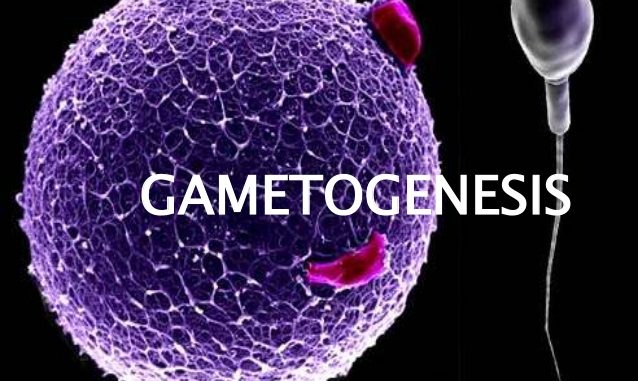- Formation of male and female gametes .
- male and female germ cells (spermatocytes and primary oocytes) at the beginning of meiosis I replicate their DNA so that each of the 46 chromosomes is duplicated into sister chromatids.
- In contrast to mitosis, however, homologous chromosomes then align themselves in pairs, a process called synapsis.
- Homologous pairs then separate into two daughter cells, thereby reducing the chromosome number from diploid to haploid.
- Thereafter, meiosis II separates sister chromatids.
- Each gamete then contains 23 chromosomes.
- Gametogenesis, the production of sperm (spermatogenesis) and eggs (oogenesis), takes place through the process of meiosis.
- In oogenesis, diploid oogonium go through mitosis until one develops into a primary oocyte, which will begin the first meiotic division, but then arrest; it will finish this division as it develops in the follicle, giving rise to a haploid secondary oocyte and a smaller polar body.
- The secondary oocyte begins the second meiotic division and then arrests again; it will not finish this division unless it is fertilized by a sperm; if this occurs, a mature ovum and another polar body is produced.
- In spermatogenesis, diploid spermatogonia go through mitosis until they begin to develop into gametes; eventually, one develops into a primary spermatocyte that will go through the first meiotic division to form two haploid secondary spermatocytes.
- The secondary spermatocytes will go through a second meiotic division to each produce two spermatids; these cells will eventually develop flagella and become mature sperm.

- now, have a look on some terms:
- spermatocyte: a male gametocyte, from which a spermatozoon develops
- oocyte: a cell that develops into an egg or ovum; a female gametocyte
- polar body: one of the small cells that are by-products of the meiosis that forms an egg
- mitosis: the division of a cell nucleus in which the genome is copied and separated into two identical halves. It is normally followed by cell division
- meiosis: cell division of a diploid cell into four haploid cells, which develop
Spermatogenesis
•The production of gametes in a males, called spermatogenesis, takes place in the testes.
•There, diploid primordial germ cells divide mitotically to produce diploid cells called spermatogonia.
•Each spermatogonium can undergo repeated rounds of mitosis, giving rise to numerous additional spermatogonia.
•Alternatively, a spermatogonium can initiate meiosis and enter into prophase I.
•Now called a primary spermatocyte, the cell is still diploid because the homologous chromosomes have not yet separated.
•Each primary spermatocyte completes meiosis I, giving rise to two haploid secondary spermatocytes that then undergo meiosis II, with each producing two haploid spermatids.
•Thus, each primary spermatocyte produces a total of four haploid spermatids, which mature and develop into sperm.
•Spermatogenesis, which begins at puberty, includes all of the events by which spermatogonia are transformed into spermatozoa.
Shortly before puberty, PGCs give rise to spermatogonial stem cells.
•At regular intervals, cells emerge from this stem cell population to form type A spermatogonia, and their production marks the initiation of spermatogenesis.
•Type A cells undergo a limited number of mitotic divisions to form clones of cells.
•The last cell division produces type B spermatogonia, which then divide to form primary spermatocytes Primary spermatocytes then enter a prolonged prophase (22 days) followed by rapid completion of meiosis I and formation of secondary spermatocytes.



•During the second meiotic division, these cells immediately begin to form haploid spermatids
•Throughout this series of events, from the time type A cells leave the stem cell population to formation of spermatids, cytokinesis is incomplete, so that successive cell generations are joined by cytoplasmic bridges. •Thus, the progeny of a single type A spermatogonium form a clone of germ cells that maintain contact throughout differentiation
•The series of changes resulting in the transformation of spermatids into spermatozoa is spermiogenesis.
These changes include:
•formation of the acrosome, which covers half of the nuclear surface and contains enzymes to assist in penetration of the egg and its surrounding layers during fertilization
•condensation of the nucleus
•formation of neck, middle piece, and tail
•shedding of most of the cytoplasm
•In humans, the time required for a spermatogonium to develop into a mature spermatozoon is approximately 74 days.


Spermatogenesis: During spermatogenesis, four sperm result from each primary spermatocyte, which divides into two haploid secondary spermatocytes; these cells will go through a second meiotic division to produce four spermatids.
Oogenesis
•The production of gametes in a female animal, called oogenesis, begins much like spermatogenesis.
•Within the ovaries, diploid primordial germ cells divide mitotically to produce oogonia.
•Like spermatogonia, oogonia can undergo repeated rounds of mitosis or they can enter into meiosis
. •When they enter prophase I, these still-diploid cells are called primary oocytes.
•Each primary oocyte completes meiosis I and divides.
•PGCs in the gonads of a genetic female, they differentiate into oogonia •These cells undergo number of mitotic divisions
•By the end of 3rd month, they are arranged in clusters surrounded by layer of flat epithelial cells (follicular cells)
•Majority of oogonia continue to divide by mitosis while some arrest their cell division in prophase 1 of meiosis and form primary oocyte
•Near the time of birth, all primary oocytes have started prophase of meiosis I, and enter the diplotene stage, a resting stage during prophase that is characterized by a lacy network of chromatin
•Primary oocytes remain arrested in prophase and do not finish their first meiotic division before puberty is reached.

•At puberty, Meiosis I is completed, resulting in formation of two daughter cells of unequal size, each with 23 double-structured chromosomes.
•One cell, the secondary oocyte, receives most of the cytoplasm; the other, the first polar body, receives practically none.
•The cell then enters meiosis II but arrests in metaphase approximately 3 hours before ovulation.
•Meiosis II is completed only if the oocyte is fertilized; otherwise, the cell degenerates approximately 24 hours after ovulation.
•During meiosis, one primary oocyte gives rise to four daughter cells, each with 22 plus 1 X chromosome
• only one of these develop into mature gamete the oocyte, the other three form polar bodies as they receive little cytoplasm and degenerate during subsequent development
•One primary spermatocyte also gives rise to four daughter cells; 2 with 22 autosomes plus one X chr and 2 with 22 autosomes plus one Y chr
• in contrast to oocyte formation all of them develop into mature gametes

Oogenesis: The process of oogenesis occurs in the ovary’s outermost layer. A primary oocyte begins the first meiotic division, but then arrests until later in life when it will finish this division in a developing follicle. This results in a secondary oocyte, which will complete meiosis if it is fertilized
Overview:




















